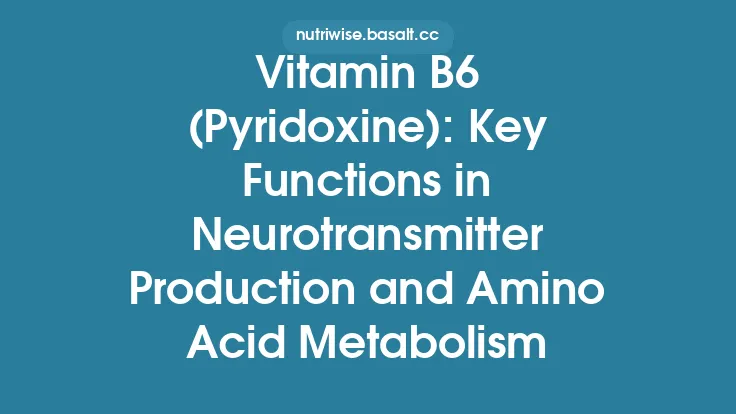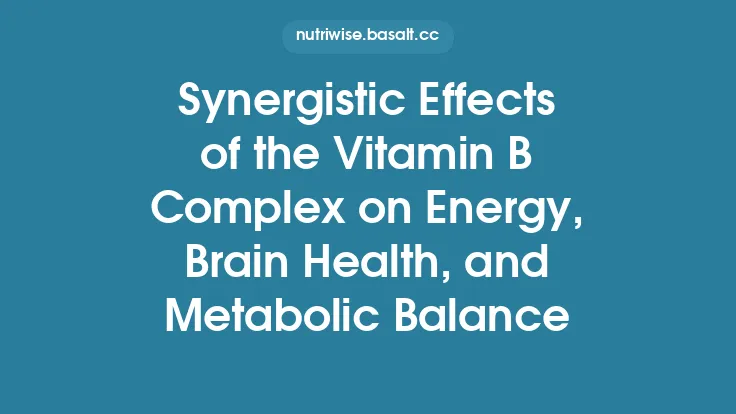Folate, also known as vitamin B9, is a water‑soluble micronutrient that plays a central role in the body’s one‑carbon metabolism—a network of biochemical reactions that transfer single carbon units for the synthesis of nucleic acids, amino acids, and methylation reactions. Because these pathways are essential for the replication and repair of DNA, the proper functioning of rapidly dividing cells, and the development of the fetus, folate status is a critical determinant of health across the lifespan. This article explores the biochemical underpinnings of folate’s actions, its physiological significance in DNA synthesis and cell division, and why adequate intake is especially vital during pregnancy.
Molecular Structure and Bioavailability of Folate
Folate exists in several interconvertible forms. The naturally occurring compound in foods is primarily pteroylglutamic acid, a polyglutamate that contains a pteridine ring linked to para‑aminobenzoic acid (PABA) and one or more glutamate residues. In the intestinal lumen, brush‑border enzymes (folate conjugases) cleave the polyglutamate chain to a monoglutamate form, which is then absorbed via the proton‑coupled folate transporter (PCFT) in the proximal jejunum. Once inside enterocytes, folate is reduced by dihydrofolate reductase (DHFR) to tetrahydrofolate (THF), the biologically active cofactor that participates in one‑carbon transfers.
Synthetic folic acid, the oxidized monoglutamate used in fortified foods and supplements, is more stable and has higher bioavailability than food folates. After absorption, folic acid is also reduced to DHF and then to THF, but the reduction step is slower, leading to transient accumulation of unmetabolized folic acid in the plasma when intake exceeds the capacity of hepatic DHFR. This phenomenon has implications for certain health outcomes and is a topic of ongoing research.
Folate in One‑Carbon Metabolism and DNA Synthesis
The core of folate’s function lies in its ability to carry and donate one‑carbon units at various oxidation states (methyl, methylene, methenyl, formyl). THF derivatives act as carriers in several key reactions:
- Purine Synthesis – 10‑Formyl‑THF donates formyl groups at two steps of the de novo purine pathway, contributing to the formation of inosine monophosphate (IMP), the precursor of adenine and guanine nucleotides.
- Pyrimidine Synthesis – 5,10‑Methylene‑THF provides the methylene group for the conversion of deoxyuridine monophosphate (dUMP) to deoxythymidine monophosphate (dTMP) via thymidylate synthase. This reaction is the sole de novo source of thymidine, a nucleotide essential for DNA replication and repair.
- Methylation Reactions – 5‑Methyl‑THF serves as the methyl donor for the remethylation of homocysteine to methionine, a reaction catalyzed by methionine synthase (vitamin B12‑dependent). Methionine is subsequently converted to S‑adenosylmethionine (SAM), the universal methyl donor for DNA, RNA, protein, and lipid methylation.
Because the synthesis of dTMP is directly dependent on folate, insufficient folate leads to uracil misincorporation into DNA, strand breaks, and chromosomal instability. These molecular lesions underpin many of the clinical manifestations of folate deficiency, including megaloblastic anemia and increased cancer risk.
Role in Cell Division and Tissue Growth
Cell proliferation demands a continuous supply of nucleotides for DNA replication and of methyl groups for epigenetic regulation. Folate’s involvement in nucleotide biosynthesis makes it indispensable for:
- Hematopoiesis – The bone marrow’s rapid turnover of erythroid precursors requires robust dTMP production. Folate deficiency impairs erythroblast maturation, resulting in macrocytic, hypersegmented neutrophils characteristic of megaloblastic anemia.
- Epithelial Renewal – Tissues with high turnover rates, such as the gastrointestinal mucosa and skin, are particularly sensitive to folate status. Inadequate folate can compromise barrier integrity and delay wound healing.
- Immune Cell Function – Lymphocyte proliferation during immune responses is folate‑dependent. Experimental models demonstrate that folate restriction diminishes both B‑cell and T‑cell clonal expansion, potentially weakening host defenses.
Beyond supplying nucleotides, folate‑mediated methylation influences gene expression patterns during development. DNA methylation, a key epigenetic mechanism, is modulated by SAM levels, linking folate status to the regulation of genes governing cell cycle progression, differentiation, and apoptosis.
Critical Importance During Pregnancy
Pregnancy imposes extraordinary demands on folate metabolism for several reasons:
- Neural Tube Closure – The neural tube forms and closes within the first 28 days post‑conception, a period often preceding pregnancy recognition. Adequate folate ensures sufficient dTMP for rapid neuroepithelial cell division and proper methylation of genes involved in neural tube closure. Deficiency markedly increases the risk of neural tube defects (NTDs) such as spina bifida and anencephaly.
- Placental Development – The placenta’s trophoblast cells proliferate extensively to establish maternal‑fetal exchange. Folate supports trophoblast DNA synthesis and modulates angiogenic factors through methylation pathways, influencing placental vascularization and nutrient transport.
- Fetal Growth – Throughout gestation, the fetus relies on maternal folate for the synthesis of its own nucleic acids and for methylation reactions that shape organogenesis and long‑term epigenetic programming. Low maternal folate is associated with intrauterine growth restriction and low birth weight.
- Maternal Health – Pregnancy‑induced hemodilution and increased renal clearance raise the risk of maternal folate depletion, which can precipitate anemia, fatigue, and impaired immune function.
Given these stakes, public health agencies worldwide recommend periconceptional folic acid supplementation (typically 400 µg/day) for women of childbearing age, with higher doses (up to 4 mg/day) advised for those with a prior NTD‑affected pregnancy or certain medical conditions.
Dietary Sources, Recommended Intakes, and Supplementation
Natural Food Sources
- Dark leafy greens (spinach, kale, collard greens) – 30–100 µg per cup (raw)
- Legumes (lentils, chickpeas, black beans) – 150–200 µg per cup (cooked)
- Citrus fruits and juices – 30–50 µg per medium fruit
- Asparagus, Brussels sprouts, and broccoli – 70–100 µg per cup (cooked)
- Fortified grains (bread, cereals) – 100–200 µg per serving (varies by country)
Recommended Dietary Allowances (RDA) (varies by age, sex, and physiological status)
- Adults (19–50 y): 400 µg dietary folate equivalents (DFE) per day
- Pregnant women: 600 µg DFE/day
- Lactating women: 500 µg DFE/day
- Older adults (>70 y): 400 µg DFE/day (to offset reduced absorption)
Supplementation Strategies
- Prenatal vitamins typically contain 400–800 µg folic acid, meeting periconceptional needs.
- Therapeutic doses (≥1 mg) are prescribed for individuals with malabsorption syndromes, certain anticonvulsant therapies, or a history of NTDs.
- Methylfolate (5‑methyltetrahydrofolate) is an alternative to folic acid for those with genetic polymorphisms (e.g., MTHFR C677T) that reduce conversion efficiency.
Factors Influencing Folate Status and Interactions
- Genetic Polymorphisms – Variants in the MTHFR gene affect the conversion of 5,10‑methylene‑THF to 5‑methyl‑THF, potentially lowering plasma folate and raising homocysteine. Individuals with homozygous C677T may benefit from methylfolate supplementation.
- Drug Interactions – Antimetabolites such as methotrexate and pemetrexed inhibit DHFR, directly antagonizing folate metabolism. Long‑term use can precipitate folate deficiency, necessitating rescue therapy with leucovorin (folinic acid). Certain anticonvulsants (phenytoin, carbamazepine) increase folate catabolism.
- Alcohol Consumption – Chronic ethanol intake impairs folate absorption, hepatic storage, and the activity of folate‑dependent enzymes, compounding deficiency risk.
- Gastrointestinal Disorders – Celiac disease, inflammatory bowel disease, and bariatric surgery can reduce folate absorption due to mucosal damage or shortened intestinal transit.
- Nutrient Interplay – Adequate vitamin B12 is required for the methionine synthase reaction; B12 deficiency can trap folate as 5‑methyl‑THF (the “methyl trap”), functionally depleting other folate forms.
Clinical Implications of Folate Deficiency
Hematologic Manifestations
- Megaloblastic anemia: macrocytosis (MCV > 100 fL), hypersegmented neutrophils, low reticulocyte count.
- Pancytopenia in severe cases due to impaired marrow proliferation.
Neurologic Effects
- While folate deficiency alone rarely causes neuropathy, it can exacerbate B12‑related neurologic deficits and contribute to cognitive decline in the elderly.
Congenital Anomalies
- Neural tube defects are the most well‑documented outcome; epidemiologic data show a 50–70 % reduction in NTD incidence with periconceptional folic acid supplementation.
Cardiovascular Risk
- Elevated homocysteine, secondary to inadequate folate (and B12/B6), is an independent risk factor for atherosclerosis and thromboembolic events. Folate repletion can modestly lower homocysteine levels, though the impact on hard cardiovascular outcomes remains debated.
Oncogenesis
- Folate deficiency can lead to DNA strand breaks and uracil misincorporation, fostering mutagenesis. Conversely, excessive folic acid intake may accelerate the growth of pre‑existing neoplasms, highlighting the need for balanced intake.
Practical Recommendations for Maintaining Adequate Folate
- Prioritize Whole‑Food Sources – Incorporate a variety of leafy greens, legumes, and fortified grains into daily meals.
- Mind Cooking Methods – Folate is heat‑sensitive; brief steaming or microwaving preserves more of the vitamin than prolonged boiling.
- Supplement Wisely – Use a prenatal or multivitamin containing 400–800 µg folic acid for women of reproductive age; consider methylfolate for individuals with known MTHFR variants.
- Screen High‑Risk Populations – Assess serum folate and homocysteine in patients with unexplained anemia, malabsorption syndromes, or a history of NTD‑affected pregnancies.
- Avoid Excessive Alcohol – Limit intake to reduce folate loss and improve hepatic metabolism.
- Coordinate with Healthcare Providers – Adjust folate supplementation when using antifolate medications or during pregnancy to ensure optimal dosing.
Future Directions and Emerging Research
- Epigenetic Programming – Longitudinal studies are investigating how maternal folate status influences offspring DNA methylation patterns and susceptibility to metabolic diseases later in life.
- Folate‑Targeted Therapies – Novel antifolate agents with selective tumor uptake are under development, aiming to exploit folate receptor overexpression in certain cancers while sparing normal tissue.
- Biomarker Refinement – Red blood cell folate measurement is considered the gold standard for assessing long‑term status; emerging assays for plasma 5‑methyl‑THF may provide more nuanced insight into functional folate pools.
- Personalized Nutrition – Integration of genomic data (e.g., MTHFR genotype) with dietary counseling could tailor folate recommendations, optimizing both preventive and therapeutic outcomes.
In summary, vitamin B9 (folate) is a linchpin of one‑carbon metabolism, underpinning DNA synthesis, cell division, and the intricate developmental processes of pregnancy. Ensuring sufficient intake through a diet rich in natural folates, fortified foods, and appropriate supplementation is essential for maintaining hematologic health, supporting fetal development, and reducing the risk of chronic disease. By understanding the biochemical pathways and clinical implications of folate, individuals and healthcare professionals can make informed decisions that promote lifelong wellness.





